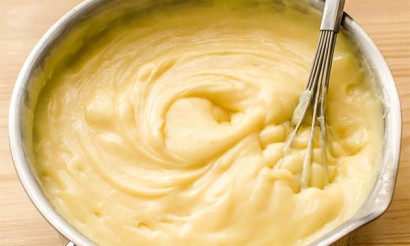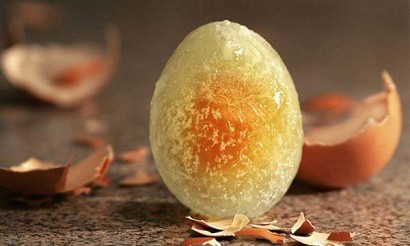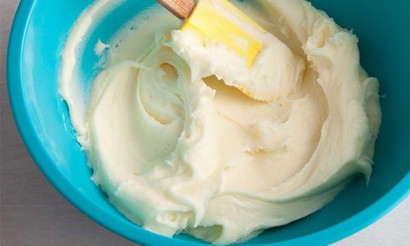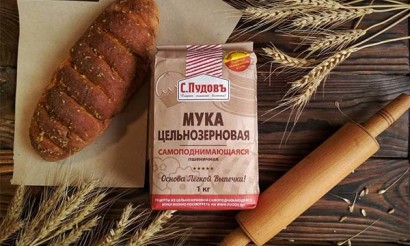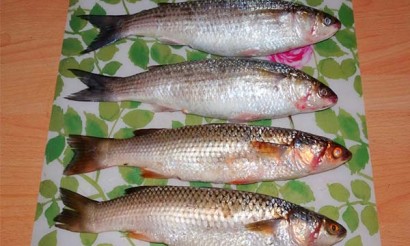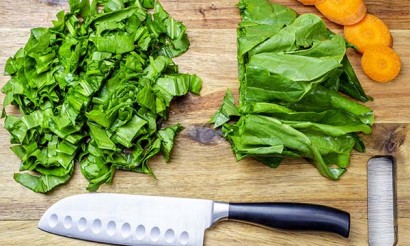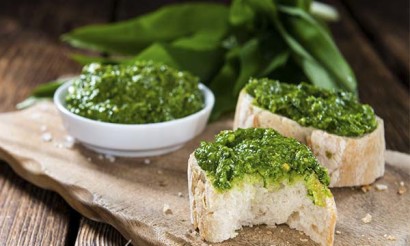What are fermented vegetables and why are they useful?
Our ancestors invented a unique way to preserve vegetables and store them for future use. This is fermentation. Chemists call it fermentation. Sourdough vegetables have caught the taste of gourmands and adherents of healthy eating. In addition, this method is always on hand for dacha farmers seeking to preserve their crops for the winter.
- What are fermented vegetables?
- What vegetables can be fermented
- The benefits of fermented vegetables
- Harms and contraindications
- How to ferment vegetables at home
- Popular Recipes of Fermented Vegetables
- Pickles
- Pickled Beets
- Cold Sourced Tomatoes
- Sauerkraut
- Pickled Garlic
- Garlic Pickling
- Sourced Sweet Peppers
- Fermented green beans
- Kimchi
- Can we give cats and dogs fermented vegetables
- What can be made with fermented vegetables
- Porridge
- Borscht with fermented beets
- Salad with sauerkraut (budget)
- Chicken with fermented sweet bell pepper
- Salad with sour beet and sour garlic (heads)
- Salad with pickles
This article reveals the concept of "fermentation" and will offer recipes for fermenting vegetables and cooking with them.
What are fermented vegetables
Fermentation is a fermentation process that occurs in the absence or lack of oxygen. A chemical reaction takes place. As a result, organic substances are broken down and new ones are formed. And the fermented product is supplemented with vitamins and trace elements.
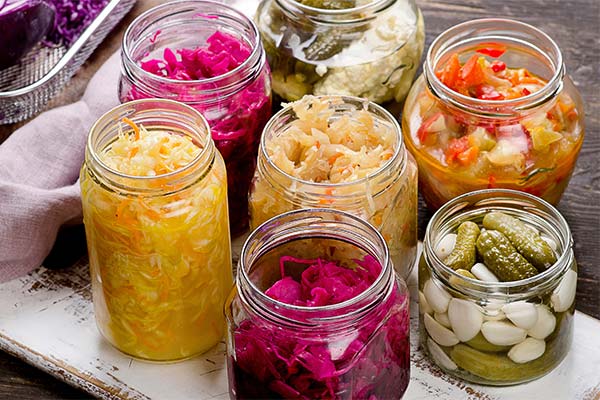
Fermentation occurs without any additives, starters. In vegetables, it is due to the action of lactic acid bacteria formed during fermentation. So, fermented foods are biologically pure. But the main attraction of fermentation is that such products are stored for a long time and do not lose their useful substances. Fermentation is already a trend in the culinary arts.
What vegetables can be fermented
Any vegetables, fruits and berries can be fermented: zucchini, cabbage, cucumbers, tomatoes, beets, apples, watermelons, cranberries, eggplants, herbs, etc. Virtually everything that belongs to the flora.
Benefits of fermented vegetables
Fermented foods improve gastrointestinal health, are a prevention of premature wrinkles, increase immunity, even prevent and treat some diseases.
The vitamins they contain boost performance and give energy to the individual.
Fermented cabbage, which is made and consumed in different countries, contains substances and vitamins that preserve and improve eyesight. Including it daily in one's diet will relieve headaches.
Soy sauce is made by fermentation with the addition of grains. This sauce increases the appetite.
Miso is a Japanese paste. It is the result of fermenting soybeans, wheat, barley, rice, and chickpeas. It contains a very high amount of protein (it replaces meat). Pasta reduces the risk of radioactive contamination, removes toxins from the body. Miso is recommended for anemia and infertility.
Harm and contraindications
There are, of course, contraindications. If a healthy person is not threatened by anything, people with chronic diseases (stomach and intestinal diseases, tachycardia, allergies, liver and kidney disease, etc.) should either limit the consumption of fermented vegetables, or abandon them altogether.
All vegetables are also useful in their raw form. But fermentation preserves them for a long time and enriches them with additional vitamins and enzymes.
How to ferment vegetables at home
Fermenting vegetables at home is not difficult. Every housewife has everything she needs. Let the term "fermentation" not be misleading. This is the seasonal preparations: pickling, soaking, curing, souring. The following are suggested ways to make these preparations.
Popular recipes for fermented vegetables
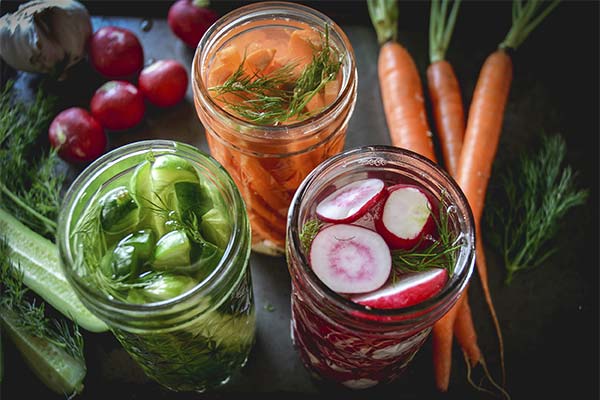
Pickled Cucumbers.
Cucumbers will turn out crispy, with a "grandma-like" taste.
Ingredients:
- Cucumbers - 1,5 kg.
- Dill (pickles) - 2 pcs.
- horseradish (leaves) - 3 pcs.
- Leaves of oak, currant and laurel - 3 pcs.
- Black pepper - 8 pcs.
- Garlic - 6 cloves.
- Coarse salt - 30 grams.
- Water - 1 l.
Method of preparation:
- Draw water and let it stand. Pour into a pot of 1 liter, without shaking the bottom. Do not use boiled or bought water.
- Add salt to the water and heat, stirring until the spices have dissolved. Do not boil.
- Stack in another bowl (not aluminum) or in jars in layers of cucumbers, leaves, peppers, garlic cloves.
- Pour the warm brine. The next day you can use as pickles. After 4-5 days fermentation is complete.
Pickled beets
Is it worth talking about the benefits of beets. So, when beets are fermented, they retain all their useful substances.
Ingredients:
- Beets of medium size, dark burgundy - 1 kg.
- Salt - 1,5 tbsp.
- Water - 1 l.
Step by step recipe:
- Grate the peeled beets on a coarse grater or shredder.
- Place in a pan for salting and pour the brine (brine do not bring to a boil, only to dissolve the salt).
- Put gauze on top, and put an oppressor on it. Quenching will last for 2 weeks. Periodically, if there is foam and mold, you need to rinse the gauze.
- Spread into jars and put in a cold place.
Cold pickling tomatoes.
Ingredients:
- Tomatoes - as many as will fit in a 3 L. jar.
- Parsley - 3-4 sprigs.
- Estragon - 1 sprig.
- Celery - 1 sprig.
- Horseradish root - 5 cm in size.
- Garlic - 1 clove.
- Dill umbrella - 1 pc.
- Cherry leaves - 4 pcs.
- coarse salt - 2 tablespoons.
- Water - 1,5 l.
Preparation:
- At the bottom of the jar put sprigs of parsley, celery, tarragon, dill umbrella, cherry leaves, garlic, chopped horseradish.
- Put the washed tomatoes in a jar. Choose ripe tomatoes (but not overripe), dense, fleshy, not large.
- Prepare the brine. Warm the water a little, so that the salt dissolves quickly (do not boil). Allow to cool completely.
- Pour the brine over the tomatoes until they are completely covered.
- Close the jar with a plastic lid and put it in a cool place. It will be ready in a month.
If preparing several jars at once, the composition of the recipe is simply multiplied by the number of jars.
Sauerkraut
Of course, next we will talk about sauerkraut (fermented) cabbage as a traditional Russian dish. Previously sauerkraut was made in oak barrels, which gave the cabbage a tangy flavor. Now there is almost no such possibility. But it is possible to achieve this effect - "as from the barrel". The cabbage will be fragrant, juicy, crispy.
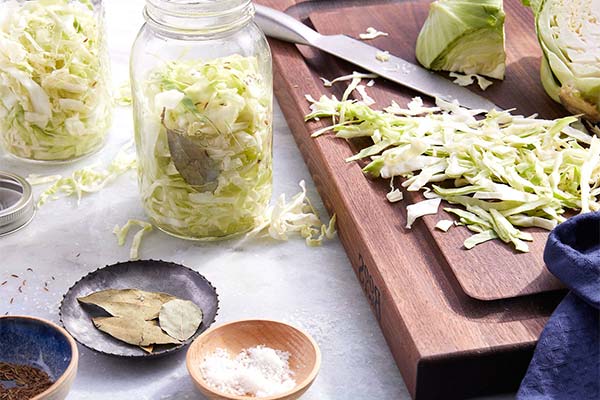
Cabbage in jars (classic)
Ingredients:
- White cabbage - 3 kg.
- Carrots - 2 pcs. (large)
- Salt (stone salt, not "Extra") - 60g.
- Bay leaf - 5 pcs.
- Lingonberry - 1 tbsp.
- Caraway seed - 0.5 tsp.
- Dill seed - 1 tsp.
- Black pepper - 5-8 pcs.
Method of preparation:
- Remove the top leaves and discard. Then remove another 5-6 leaves and put aside.
- Shred the cabbage in julienne.
- Grate carrots on a coarse grater or shredder.
- Cabbage, salt, carrots and peas mix well in a wide bowl (basin). There is no need to crush.
- At the bottom of an enameled bucket put 2-3 leaves of cabbage so as to cover the bottom.
- Put the mixture from the basin in batches. Sprinkle each layer with cranberries, cumin and dill (seeds), add 1-2 leaves of dill (you can do without it). Knead each layer firmly so that the juice is formed.
- On top, cover with remaining cabbage leaves and knead again.
- Place a wooden circle over the whole cabbage, and place a heft over the top.
- Keep at room temperature for 3 days. During this time the fermentation process will take place. From time to time, poke the mixture with a long stick, so that it reaches the bottom. This is to remove the gas, which can give the cabbage an unpleasant taste.
- After three days, the cabbage is tightly tamped in sterilized jars, cover with plastic lids scalded with boiling water. You don't need to roll it up.
Whole sauerkraut leaves can also be used: line the bottom of the jar and put on top of the cabbage (as much as enough). Store in the cellar or refrigerator.
Fermented cabbage with red beets
Ingredients:
- White cabbage - 8 kg.
- Beets - 1-2 medium pieces to taste.
- Garlic - 100 gr.
- Horseradish (root) - 100 gr.
- Parsley (herbs) - 100 gr.
- Water - 4 liters.
- Salt - 100 gr.
- Sugar - 100 gr.
Recipe:
- Cut the spines out of the cabbage and cut into large pieces (about, 200 g).
- Chop the garlic and parsley, and cut the beets into slices. Grate the horseradish on a grater.
- Mix all the vegetables and put them in a bowl full of enamel.
- Prepare a brine. Add salt and sugar, boil and cool (the brine must be warm).
- Pour the brine over the cabbage.
- Ferment at room temperature for 2 days.
- Stack tightly in jars, close with plastic lids and place in the refrigerator (cellar) for 5 days. Done.
Sauerkraut with apples
Ingredients:
- White cabbage - 10 kg.
- Rock salt - 7 tbsp.
- Carrots - 350 gr.
- Apples - 1 kg.
- Berries - 200 gr. (lingonberries or cranberries, or all together)
How to prepare:
- Shred the cabbage (without the core). Part of the cabbage cut into large chunks (200-300 grams).
- At the bottom of the dish for salting, put a few cabbage leaves to cover the bottom.
- Mix the cabbage with grated carrots.
- Put a layer of cabbage and salt (calculate the salt so that there is enough salt for all the layers).
- Next - a layer of sliced apples. Season with salt.
- Next - a layer of berries.
- Put slices of cauliflower.
- Cover with shredded cabbage and season with salt. Alternate until all the vegetables are done.
- Put cabbage leaves on top, season with salt, and cover with gauze. Cover the top with a wooden circle (or dish, flat plate) and put a weight on it.
Leave to ferment at room temperature for 6-7 days. When the foam appears, you need to remove it from time to time. Also periodically poke with a stick, reaching to the bottom. In a week it is ready. In the same pot take away to a cool place.
Pickled garlic in heads
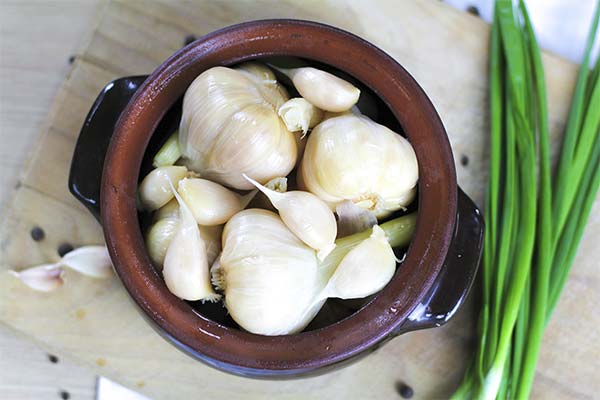
Ingredients:
- Garlic heads - by the volume of the jar.
- Garlic shoots - by the volume of the jar.
- Sugar - 1 tsp.
- Salt - 2 tbsp.
- Dill - 1 bunch of herbs, umbrella - 1 pc.
- Beets - 1 pc medium.
- Cherry leaves, currant leaves - 2 pcs.
- Peas - 5-6 pcs.
- Water - 1 l.
Method of preparation:
- Wash the arrows and cut into pieces (size - as desired).
- Garlic heads with cut rhizomes and peduncles, soak in cold water for 1 hour. After that, clean off the top husk, leaving the inner. Garlic should be a new crop, young.
- It is necessary to prepare a marinade. Boil water with salt and sugar and cool.
- At the bottom of a clean jar, put the peppers, dill umbrella, currant leaves, cherries.
- Put the garlic heads and arrows, beets cut into strips (beet juice will do instead), cover the top with dill greens.
- Pour the brine, put in a tray.
Next observe the fermentation (10 days). Room temperature is necessary. Appearing foam all the time to remove. When the process is over, cover with plastic lids and put it in the fridge.
The appetizer is incredibly fragrant, with a tangy flavor. Helps replenish the body with vitamins, so necessary in the cold season.
Fermented vegetables are stored in a cold place under polyethylene or screw caps for up to 3 months. But this period can be extended. It is enough to make a solution of water and salt (20 grams of salt per liter of liquid) and topping up as needed.
Quenching garlic shoots
Ingredients:
- Garlic shoots (green) - the number is determined by the number of jars.
- Sugar - 100 gr.
- Salt - 100 gr.
- Water - 1, 5 liters.
Recipe:
- At the garlic shoots cut the inflorescences and discard. The resulting raw wash and cut into 3-4 cm long.
- Place in jars up to the top, but not with a hill.
- Prepare a brine. Add salt, sugar and boil in the water.
- Put jars with garlic in a tray and pour cooled brine.
The tray is needed so that during fermentation the foam does not spill on the table. The process will take 5-8 days. You will need to keep an eye on the brine level. If necessary, you can refill it. Then close with plastic lids and put in the refrigerator.
Sourced Sweet Peppers
Ingredients:
- Bell peppers - 1 kg.
- Garlic - 2 cloves
- Dill - 2 umbrellas
- Parsley - 2 twigs
- Peppercorns - 10 units.
- Salt - 3 tbsp.
- Water - 1,5 l.
Method of preparation:
- Wash the peppers, cut out the stalks and prick with a toothpick.
- Wash the spices. Cut the garlic into strips.
- Put part of the spices in the bottom of a 4-liter enamel saucepan.
- Then put the bell peppers. It will settle as it ferments.
- Add the rest of the spices.
- Dissolve salt in cold water and pour over the pepper.
- Put a plate on top so that the pepper is sunk. You don't need a crust.
Keep all at room temperature 3 days. Transfer to jars, cover with plastic lids and put in the fridge. This is a very flavorful and healthy snack. And if you pick peppers of different colors, it will look beautiful.
Fermented green beans.
Ingredients:
- Beans - 2 kg. (green beans)
- Salt - 100 gr.
- Sweet pepper - 2 pcs.
- Hot pepper (green beans) - 1 pc.
- Garlic - 2 heads
- Water - 2 liters.
- Celery (optional) - 2 sprigs.
Cooking process:
- Wash the beans, remove the hard fibers from the sides, and cut off the ends.
- Prepare the brine: boil water with salt and cool.
- Cut sweet peppers into squares, hot peppers - very thin julienne. Pepper should be cleaned of stalks and seeds.
- Boil water in another pot and boil the beans for 1 minute. The beans should be dropped only into boiling water.
- Blanch chopped peppers (sweet and hot) and celery in the boiling water in which the beans were boiled. To do this, place the peppers in a metal sieve and drop them into the pot of boiling water for a few seconds. Do not boil them! Take them out, let them drain and cool.
- Chop the garlic, but do not use a garlic masher.
- Place in layers in an enameled bowl and carefully, through a slotted spoon, pour the brine over them.
- Cover with a wooden circle or plate and put a weight on it. A half-liter jar of water is enough.
Beans will ferment for 4 days. Then you can use them. Transfer to jars, cover with plastic lids. Store in a cold place. If anyone finds it very salty or spicy (this is the Armenian dish tursha), you can wash this snack in a sieve. It will not lose its useful qualities. Before eating you can add vegetable oil, if desired.
Kimchi
And now for some exotic dishes. This is an ancient Korean dish with a spicy taste for spicy lovers. Koreans make everything "by eye," based on their tastes. But since the delicacy is not "ours," the recipe must be followed, at least approximately.

Ingredients:
- Peking cabbage - 2 bales.
- Soy sauce - 2 tbsp.
- Garlic - 1 head.
- Onion - 1 large head.
- Ginger - 50-70 gr.
- Sugar - 1 sp.
- Salt - 1 tbsp.
- Hot pepper - to taste. (You can take both powder and a pod)
Method of preparation:
- Separate the Beijing cabbage into leaves and coarsely chop them. Put them in a stack and cut across.
- Peel and grate the ginger.
- Chop onion, garlic (as you like).
- Mix salt, sugar, pepper, garlic, onion, ginger and soy sauce.
- Arrange in layers of Peking cabbage and mixture.
After 3 days of fermentation (fermentation) at room temperature, the dish is ready to eat.
Can I Give Fermented Vegetables to Cats and Dogs
Vegetables are useful not only for people, but also for pets. Therefore, owners make sure that their diet is balanced and teach them to eat vegetables.
But as for fermented vegetables, there is a caveat. The spices they contain cause animals to metabolize. And salt affects the urinary system. Urinary stones can form. And it is unlikely that cats and dogs will eat sauerkraut because of the specific smell. Pets have a salt-free diet. Plus, cat and dog food already contains vegetables. Still, it is possible to prepare a healthy product for them as well.
Fermented vegetable smoothie for dogs
Ingredients:
Apples, carrots, pumpkin, zucchini, Beijing cabbage (white cabbage makes dogs fart), nettles, beet and carrot tops, spinach, herbs, lettuce - about proportions below. You don't have to use all the vegetables at once. You can make from 2, 3. and next time - with others.
Kefir - the amount is determined by serving.
Method of preparation:
- Everything is washed and grated on a fine grater. When the pet gets used to it, you can do it on a coarse. Leave the skin - it has a lot of vitamins. Chop parsley in a blender, but not to a pulp.
- Add the kefir and mix everything thoroughly. Add enough kefir to make a paste-like mass, not a soup.
Vegetable chowders will sour at the expense of kefir fungus for twenty-four hours.
Here's the hard part, getting them accustomed. But, knowing that all animals are curious, give the dog a teaspoon on the palm first. He will lick it anyway, "kissing" the owner. Then a teaspoon into a bowl. And then you just need to increase the amount of cocktail. If you accustom your pet to this healthy product, he won't have any problems with digestion. In addition, it is a natural vitamin product. Just remember that onions for dogs, in any form, are strictly forbidden!
As for the recipe measures, you should keep in mind: the cocktail is stored only 3 days in the refrigerator. So, you have to prepare a limited amount. And everything is taken one to one, except parsley (a handful).
But it's difficult to accustom cats to vegetable dishes. It is good if the owners will start doing it when the pet is still at the age of a small kitten. With cats is much more difficult, and the issue of vegetable nutrition is acute. They quickly become accustomed to a certain diet and require only it.
The lifesaving cucumber comes to the rescue. Many cats eat it. But for animals, you need fermented vegetables. They certainly will not harm, but on the contrary - will solve many health issues.
Fermented cucumber for cats
Ingredients:
- Fresh cucumber - 1 pc.
- Kefir - 0,5 tbsp.
Cooking recipe:
- Wash the cucumber and grate it on a fine grater.
- Mix with kefir and leave for 1 day at room temperature. Then keep in the fridge for 2-3 days.
The smell of cucumber and milk product will attract the cat.
What you can make with fermented vegetables
Fermented vegetables can be used not only as tasty snacks, but they can also be used to make hot dishes.
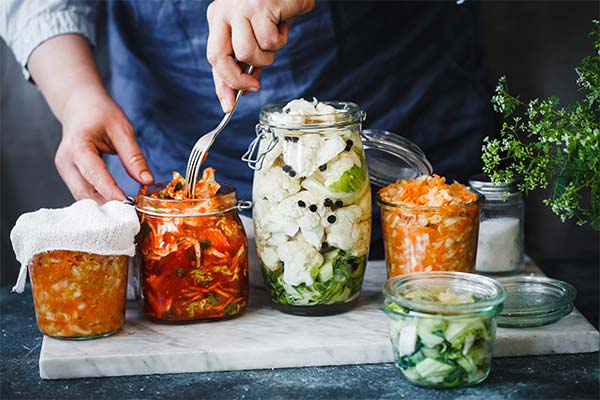
Russolnik
This is a royal dish if you prepare it properly. First, everything is done as usual. Take 3/4 cup of pearl barley and soak for the night. In the morning, add 2 tbsp of water, boil and cook over low heat. At the same time, a sauté of onion (1 pc), carrots (1 pc medium) and tomato paste (1 tbsp) is prepared. By the way, the tomato can be replaced by fermented grated tomatoes. In a pot with barley, add the roasted, diced potatoes. Cook until tender. And at the end of cooking add spices and salt to taste. And, of course, pickles! Do not wash. Chop them up finely. Add them to the soup and cook for 1 minute. Cassolnik is ready. Serve with sour cream.
Borsch with fermented beets.
In a pot cook the meat (necessarily on the bone) for 40 minutes after boiling. Foam remove until it disappears completely. Foam itself does not affect the taste of the soup. This is just clotted protein. But it spoils all the appetizing appearance. Then take out the meat, separate from the bone and chop. Throw the bone away. Return the meat to the pot.
Shred cabbage and add it until the hostess is satisfied with the thickness of the future borscht. Continue to cook on low heat.
Make a browning in vegetable oil (some use animal melted fat) of onions, carrots and tomato paste (again, you can replace the salted) and add a couple of spoons of fermented beets. Send it all into the pot.
Add diced potatoes and cook until tender. Salt to taste. Turn off the heat and allow to stand for 15 minutes.
Prepare cabbage soup made from sauerkraut in the same way. Only beets are excluded. Fresh cabbage is replaced by fermented cabbage.
Salad with sauerkraut (budget)
There are situations when there is no possibility to serve a salad to the second course. There is a way out. Peel the onion and cut as thinly as possible in half rings. Rinse the onions under cold running water in a sieve, let them drain. Put the sauerkraut in a bowl, add the onions, a little vegetable oil and mix well. Do not be afraid if it seems that there are a lot of onions. Washed has no spiciness. It should be a lot. Before serving, place in a salad bowl. The taste of this salad will surprise many.
Chicken with fermented sweet peppers
Need any pieces of chicken: thighs, shanks, wings. Breast is better not to take. It is dry and requires special preliminary preparation. Quickly fry the pieces of chicken on both sides in a saucepan over high heat in plenty of oil. This is to create a crust that will prevent the juices from running out.
In another pan, fry the onion, carrots, add the tomato paste or pickled tomatoes from the recipes above. Add fermented bell peppers. Put it all in a saucepan with the chicken, add some broth or water. Taste and season with salt. Braise over low heat until softened. Spices you can not add - fermented peppers already have them.
Salad with sour beets and sour garlic (heads)
Take hard cheese (150 g) and grate it on a fine grater. On the side that keeps the shape of shavings. In a bowl, mix the cheese, 3 tbsp. of sour beets. Add crushed with a garlic masher 1 head of fermented garlic and 3 tbsp mayonnaise. Mix everything and put it into a salad bowl.
Salad with pickles
Ingredients:
- Salted cucumbers - 2 pcs.
- Eggs - 3 pcs.
- Potatoes - 3 pcs.
- Mayonnaise - 3 tbsp.
- Onions - 0,5 heads.
Method of preparation:
- Boil the eggs and potatoes. The potatoes can be boiled in their jacket and then peeled.
- Eggs and potatoes cool, cut into small cubes.
- Finely chop pickles.
- Onion cut into thin half rings and rinse in cold water.
- Put all ingredients in a bowl, salt to taste and mix thoroughly. Done.
And this is just a small fraction of what you can make from fermented foods.
As a matter of fact, people around the world have been doing it for a long time: salting, soaking, canning and drying. At the same time, they don't even know that they are fermenting. They just don't hear the word. No one would brag to his neighbor, "I fermented two barrels of apples today.
Many people have no idea that they have a chemical laboratory. In it, they give products a new taste, saturate them with new useful substances, and extend their shelf life. Even scientists around the world are interested in this transformation of products. Russian experts unanimously assert: "Pickled, pickled, and salted foods are our food!"
«Important: all the information on this site is provided for informational purposes only. purposes only. Please consult with a specialized professional before applying any recommendations. health care professional before applying any of the recommendations. Neither the editors nor the authors shall be liable for any possible harm caused by materials."

